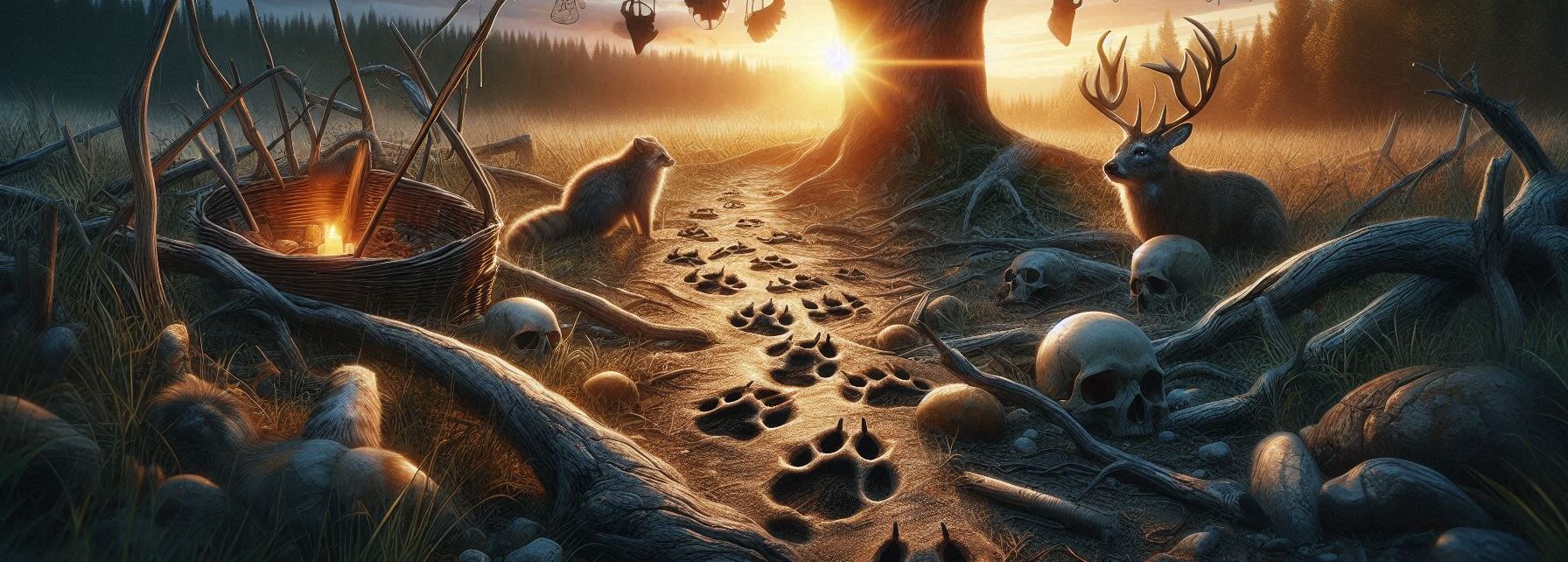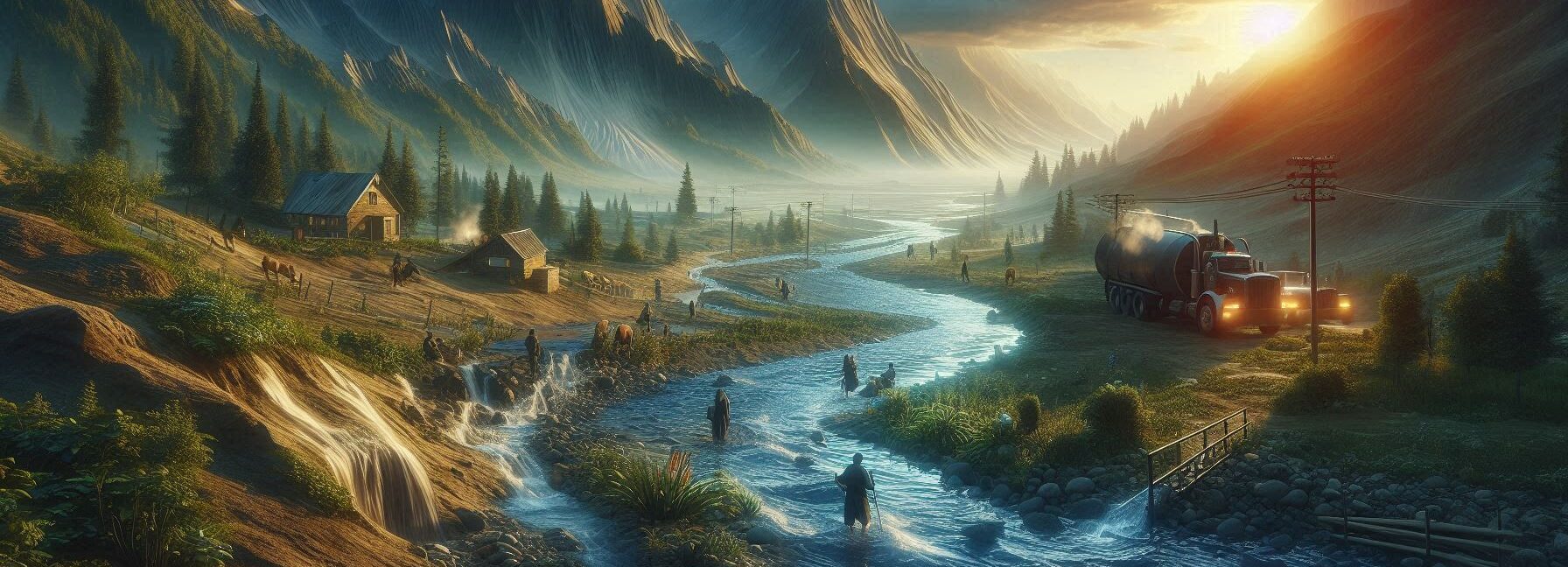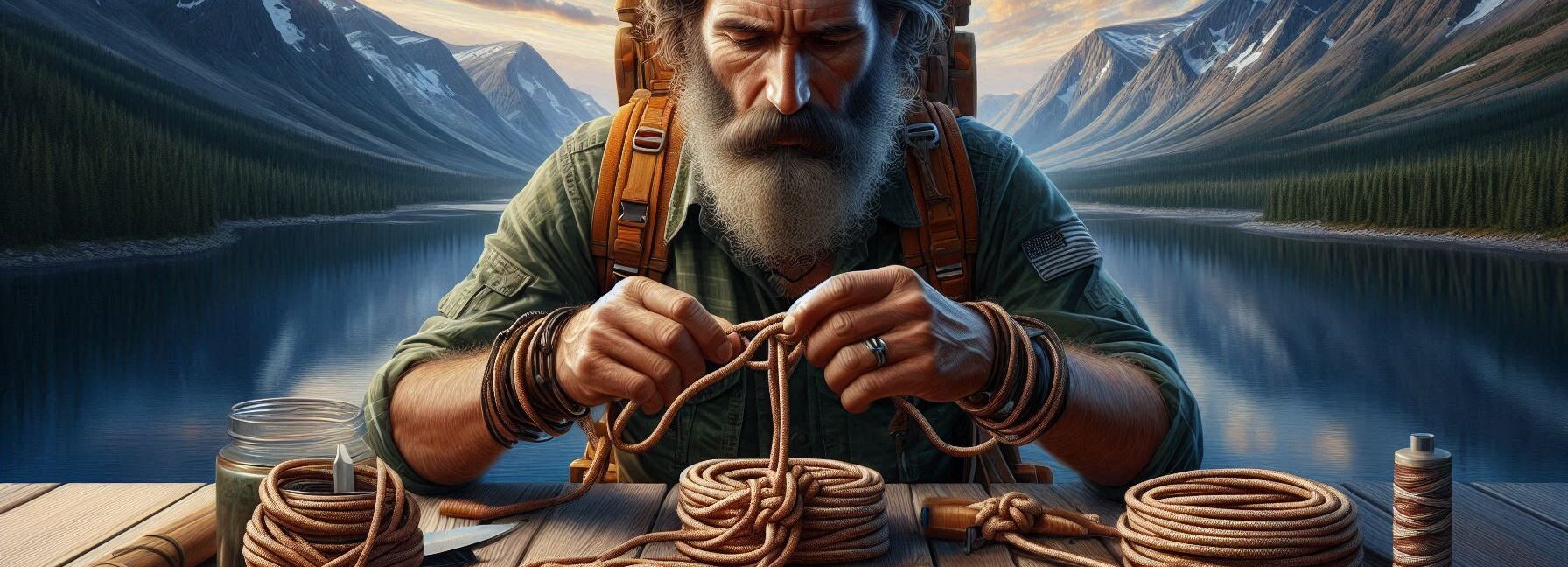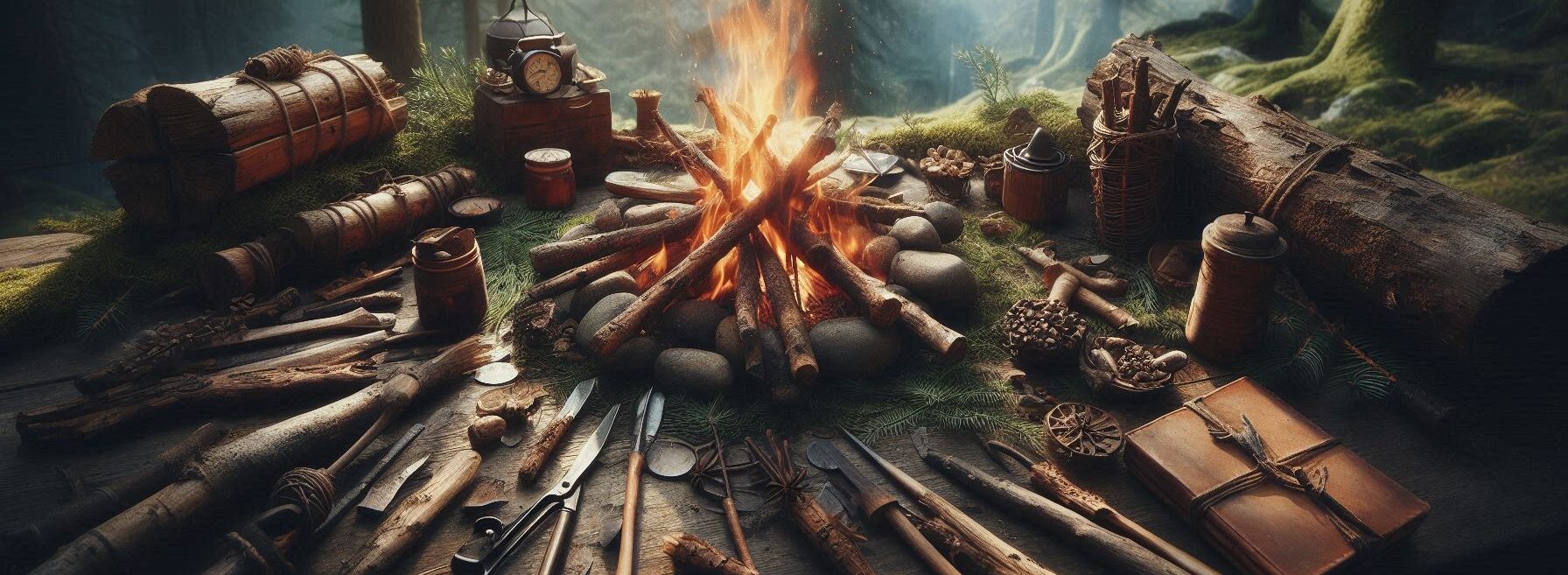Please Note: This post may contain affiliate links. If you click one of them, we may receive a commission at no extra cost to you. As an Amazon Associate, I earn from qualifying purchases.
Last Updated on November 1, 2025 by Kevin Collier
If you know a few excellent survival skills, they can make the difference between a fun experience and a full-blown calamity when you're out in the wild. It's important to know how to deal with unforeseen events whether you're planning a camping trip for the weekend or just fantasizing about one. Let's get started with some important tips that will keep you safe and sound while you're out in nature. Grab your stuff!
Top Takeaways and Key Concepts
– Prioritize the Rule of Threes: shelter, water, fire, then food.
– Build a signal plan: whistle, mirror, fire, satellite messenger.
– Master navigation: map, compass, pace count, and terrain association.
– Carry a trauma kit and practice tourniquet application.
– Practice fire skills in wet conditions with multiple ignition methods.
Understanding Basic Survival Needs

Let's talk about the most important topics first! When you're in the wild, you need three things to stay alive: shelter, water, and food. Imagine them as your three essential tools for staying alive: Batman, Robin, and Alfred, but with less capes and more tree branches.
People don't want to be caught in an unexpected rainfall without a dry place to hide, thus shelter is quite important. You may make a temporary shelter out of natural resources like fallen branches and leaves. Keep in mind that Mother Nature doesn't always play nice, so practice making these shelters before you need one!
Next on our agenda is water. It's important to drink enough water to keep your energy up. You don't want to feel like a withered plant halfway through your journey! Always have water purification tablets or a portable filter with you so you can safely drink from lakes and streams. Believe me, it's better than living on those strange energy bars that taste like cardboard.
And then there's the cuisine! It could be tempting to carry solely snacks (who doesn't love trail mix?), but understanding how to find edible plants can help you if you are stuck longer than you thought. Imagine being out in the wild, feeling like a real explorer, but running out of snacks. Those granola bars don't seem so numerous anymore all of a sudden. That's where foraging comes in. It's like unearthing hidden treasure in the wide outdoors!

Foraging isn't simply a strategy to stay alive; it can also be a fun way to get to know nature. Imagine walking through a forest and finding wild berries or nice greens that you can add to your lunch. But before you start picking everything that seems tasty, let's get one thing straight: you really need to know what you're picking! Eating something harmful by mistake is the quickest way to ruin a trip. It's like inviting trouble over for dinner without asking if they have any food allergies.
To start foraging, learn about the common edible plants that grow in your area. Dandelions are surprisingly useful; they're not simply weeds! You may eat their leaves in salads or brew their roots to make coffee (who knew?). Wild garlic is another great find. Its strong smell and taste can make any dish better and keep vampires away.
*** Shop for Survival Gear - Tools - Kits ***
Survival Gear - Bags and Backpacks - Knives - Boots/Footwear - Communication
Outdoor Cooking - Gloves - Hydration - Dry Boxes - Water Filtration Systems
Tents - Sleeping Bags - First Aid Kits - Multi-Tools - Flashlights - Fire Starters
Navigation - Survival Food - Night Vision - Headlamps - Stun Guns - Binoculars
Some plants, on the other hand, look incredibly enticing but could lead you down a dangerous path, both literally and figuratively! Mushrooms, for example, are known to be quite hard to identify because many types are poisonous and can make you very sick if you eat them. If you're not sure if a mushroom is safe, it's preferable to leave it alone instead of risking becoming a scary story told around campfires.
It's also a good idea to understand about seasonal changes because some plants may only be available at certain times of the year. As spring turns into summer, you'll see a lot of natural foods growing around. For example, nettles and clover flowers will be available to pick! When you know more about the plants in your area, you'll be better prepared for the unexpected.
Last but not least, always use sustainable foraging methods! Only take what you need, and leave enough behind so that other people and animals can enjoy these natural riches as well. Being aware of our surroundings makes sure that everyone may enjoy nature's pantry and keep it safe for future explorers.
So, the next time you pack your luggage for a trip outside, think about bringing some food and some knowledge about the plants that grow in the area. Who knows? You might find new flavors that make your camping meals unique and keep you from becoming hungry when adventure calls!
Navigating with Confidence

Being lost in the woods can feel like being on a real-life version of “Survivor” without the cameras. Let's be honest, no one wants that type of drama! You need to know how to use both a map and a compass to get around. GPS gadgets are excellent until they run out of battery or lose signal, which happens more often than you might expect.
First, learn how to interpret topographic maps. They give you important information about variations in elevation and the features of the land that can help you find your way—or send you straight into a swamp party if you're not cautious! When I practice my navigation abilities ahead of time, I feel like I'm channeling my inner explorer, but without the pith helmet.

If technology lets you down (which it does a lot), use natural features like mountains or rivers as points of reference. Imagine yourself in the woods with no phone battery and your GPS has gone on an unscheduled trip. You feel like a character in a survival movie all of a sudden, but instead of freaking out, you may be an adventurer! It's time to use nature's own navigation system.
Let's start with the mountains. Not only are they nice to look at, but they may also be great guides. You can use mountains to find your way if you know the area well or at least have a rough sense of it. Most people can find their way to large peaks even when they're lost in contemplation or deep in the woods. Just keep in mind which way they are from where you started! I always say that if you can see a mountain range in front of you, it's probably best to go toward it than of away from it. Unless you're trying to get away from a bear or something else scary!
Now let's talk about rivers, which are like roads in nature. Rivers are cool because they go downhill (who knew physics could be so useful?). If you don't have a map and don't know where you're heading, it's usually a good idea to follow the water downstream. It usually takes you to a beneficial place, like civilization or at least some friendly animals that can help you find your way home. Unless you've ended up in an other universe with talking animals and trees that can think, which would make for a really interesting story.
Rivers typically connect bigger bodies of water, like lakes or seas, which is interesting. If you happen to find one while walking around the woods, stick tight! You could run into people fishing or having a picnic nearby who can help you find your way.

But we shouldn't forget about other natural signs as well! Think of objects that jump out in your mind, like unique rock formations or certain kinds of trees. For example, there might be a huge oak tree that seems like it belongs on a postcard. These things can assist you remember where you've been and where you need to go next.
Of course, utilizing nature to find your way isn't always reliable; occasionally those landmarks can make things more perplexing than they help. But when everything else fails—and trust me, it will—it's much better to use what's around you than to sit down and cry over that broken phone in your pocket. Take in the wilderness surrounding you!
In the end, don't underestimate how well Mother Nature can help you find your way home when technology fails you. Stay cool and follow those rivers down; after all, adventure is right around the curve, even if it's not what you had in mind!
Fire-Making Fundamentals

Let's be honest: fire is great! It keeps us warm on cold nights under the stars, is a great way to cook, and lifts our spirits after a hard day of hiking through who-knows-where. But kindling a fire isn't always as straightforward as rubbing two sticks together and saying positive things.
To assist things get going quickly, I suggest packing waterproof matches or a lighter and some tinder, such dry leaves or grass. If you're feeling brave, try learning how to make sparks using flint pebbles. It's not only cool, but it will also impress people around the campfire!
Don't forget about safety after your fire is going strong! I all, who doesn't enjoy a nice campfire? It's the center of any outdoor gathering, where people tell stories, roast marshmallows, and sometimes tell ghost stories, but not while someone is carrying a blazing stick. But before you get too comfortable with that flickering flame, let's speak about how to keep it safe.

First things first: keeping things in check is important! You want to keep your fire in the right spot. You can block those flames from wandering off into the night like a youngster who wants to go on an adventure by putting them in stones or metal containers. You made a magnificent fire ring out of rocks, and then the flames decide to venture outside of it and explore. You end up throwing an unplanned campfire festival that would make Smokey Bear cry tears of disappointment. Trust me, no one wants that type of drama!
How do you set up a fire that is safe? First, make some room around your fire pit. Get rid of any dry leaves, twigs, or other things that could catch fire nearby. They tend to act like they're trying out for “The Great Fire Escape.” The last thing you want is for your snug little fire to spread quicker than family gossip.
Use bigger stones that won't break when they get hot to make your fire ring. You might think tiny stones are cute and rustic, but when they blow up (yes, it happens), they aren't so cute anymore. And if you're using a metal container like a portable fire pit or grill, make sure it's on level ground so it doesn't tip over when people start dancing around the flames.
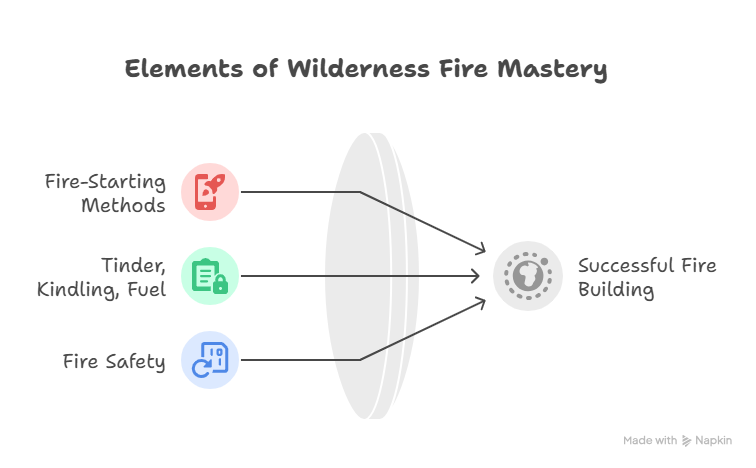
Let's talk about what kind of fuel to use. It could be tempting to put everything that could catch fire on the fire, even those old sneakers you promised to throw away, but don't do it! Use only seasoned wood and kindling that is suited for burning. Stay away from treated woods and plastics since they can let dangerous chemicals into the air. No one wants their campfire to smell like trash from last week!
As the night goes on and everyone becomes used to the warmth of the fire, keep an eye on your kids and dogs. They might think that flashing light is a sign that they should have some fun right away, like rushing through flames and acting like superheroes. Believe me, there are safer methods to feel strong that don't involve fire risks.
Also, always have water or sand on hand just in case things go out of hand or someone throws their marshmallow stick into the fire (which happens more often than you'd think!). A bucket of water or mud can be quite useful for putting out any sparks that go out of control before they take off.
Last but not least, and this is very crucial, never let your fire alone! You might think it's safe while you're busy cooking hot dogs or telling scary stories, but remember that even little fires can get out of control rapidly. So keep an eye on it as closely as you would a pot of pasta that is boiling (since no one wants burnt noodles).
In short, having fun and relaxing by a campfire should not be about being scared of the flames getting out of control. If you really mean it when you say that these easy safety measures will keep everyone safe, like keeping your fire in stone rings or metal containers, you may have a nice time camping without turning it into an unintended forest bonanza. So, come together safely and enjoy those times beneath the sky!
First Aid Know-How

Accidents happen, even in paradise. That's why it's important to acquire some basic first aid skills that could save a life or at least keep someone from getting hurt badly. Put together a small first-aid kit containing bandages, antiseptic wipes, pain medications, and other common items.
But here's where things get interesting: knowing how to treat common outdoor ailments like sprains and bites might really come in handy when someone trips over their own feet attempting to grab the perfect selfie by that beautiful waterfall! It also helps your organization feel more confident if everyone knows what to do when something goes wrong.
Also, knowing how to spot the signs of hypothermia or heat exhaustion is like having a secret weapon in your outdoor adventure toolkit. I know, I know—this could sound as boring as watching paint dry on a wet day. But believe me, this information could be very useful someday when you're far away from civilization and trying to figure out why Timmy thought his hiking boots were made for playing in the water instead of keeping his feet dry!

Let's start with hypothermia because it may sneak up on you faster than a squirrel snatching your food. Hypothermia is when your body loses heat faster than it can make it. This usually happens when the temperature drops suddenly or when you are wet and windy. So, how can you tell whether someone is going down that slippery slope? Look for signs like shaking, bewilderment, slurred speech, and a general sense of exhaustion that makes them want to curl up beneath a bush and take a nap. This sounds nice until you realize it's not the greatest way to stay alive.
It's essential to act quickly if you or someone else shows these indicators (like Timmy, who might still be thinking about that excursion in a boot full of water). Get them out of the cold right away, preferably to a warm place, and take off any wet clothes. Put blankets or sleeping bags around them like they're a burrito right off the grill. At this stage, hot drinks are also helpful. Just keep away from alcohol because it might make your body temperature drop even more (and we don't want anyone getting drunk while trying to remain warm).
Now let's switch gears and talk about heat exhaustion. Just like being too cold may be harmful, being too hot can be problematic, especially if you've been hiking up a hill like you're training for an Olympic marathon. When you are too hot and dehydrated, your body gets too tired and can't handle it. You might feel weak, dizzy, nauseous, or get headaches that feel like there's a marching band inside your head. These are all signs that you might have a problem.
What should you do if Timmy starts to appear less like a happy hiker and more like he just run a marathon through the Sahara Desert? First things first: get out of the sun! Getting out of the sun will help him cool off a lot. Then give him some water (not soda or energy drinks, which don't help with hydration) so he can rehydrate without turning into a human raisin.
And this is where things become really interesting: it's just as important to know how to avoid both scenarios! Always check the weather before you go hiking in the winter or on hot summer days. In colder weather, wear layers of clothing that are appropriate for the weather. In hotter weather, wear clothes that breathe. You don't want to get stuck beneath a lot of layers like an onion!
Also, think about taking stops often. They allow everyone, even Timmy, a chance to drink some water and regain their breath before continuing on the walk. Do you remember the snacks you packed? They aren't just there for enjoyment; they give you the energy you need to keep going without becoming tired.
Lastly, and I can't say this enough, make sure that everyone in your group can talk to each other about how they are feeling during the hike. Take people seriously when they say they're too hot or too chilly! No one wants their pleasant trip to turn into an episode of “Survivor: Trail Edition,” especially not because someone decided it would be smart to fill their boots with creek water instead of wearing them correctly.
In the end, learning how to recognize the indications of hypothermia and heat exhaustion may seem monotonous now, but these teachings could save lives when you're out in nature! So, before you go on an excursion, make sure you know this so that the next time Timmy wants to fill his hiking boots with water instead of wearing them properly, you'll have options instead of just shaking your head in astonishment!
The Importance of Teamwork

Last but not least, never underestimate how crucial it is to work together when you're outside! Having trustworthy friends makes you feel better and makes sure that everyone is there for each other when things become tough (like when you have to figure out who forgot the s'mores ingredients!).
Before you go hiking together, make sure you have clear ways to talk to each other. For example, if someone is shooting pictures and falls behind, you may set up meeting spots so that you don't accidentally become “lost” while you're out hiking. Plus, telling stories around the campfire helps people bond in ways that will linger long after they get home—not just stories about Timmy's bad shoe choices!
In the end, learning great survival skills doesn't have to be scary. Instead, think of them as ways to enjoy life outside without letting fear control every choice you make along the beautiful routes ahead!
Frequently Asked Questions
What should be prioritized first in a survival situation?
Follow the Rule of Threes and secure shelter, water, and fire before worrying about food.
How important is signaling gear when stranded?
Whistles, mirrors, and satellite messengers improve your chance of rescue by making you easier to locate.
Why should you learn map and compass skills even with GPS?
Electronics can fail, so manual navigation skills ensure you can still move with purpose and direction.
How can you practice fire-starting effectively?
Train in wet conditions using multiple ignition methods so you can light a fire when conditions are worst.
What first aid items should be carried in the wild?
A trauma kit, tourniquet, antiseptics, and basic medications prepare you to stabilize injuries until help arrives.
Why is recognizing hypothermia and heat exhaustion important?
Early understanding of symptoms lets you intervene before conditions escalate into life-threatening emergencies.
Does teamwork play a role in survival success?
Shared tasks, communication, and mutual oversight reduce mistakes and improve decision-making in stressful situations.
Suggested Resources
Essential Wilderness Survival Skills
https://www.wilderness-survival.net/skills/
The Ultimate Guide to Camping Safety
https://www.rei.com/learn/expert-advice/camping-safety.html
Outdoor Survival Tips for Beginners
https://www.outdoorlife.com/survival-tips-beginners/

Kevin Collier is a seasoned survivalist and expert in prepping and homesteading, contributing to WiseSurvive.com. With a deep-rooted passion for self-sufficiency and outdoor survival skills, Kevin shares practical advice, strategies, and resources to help individuals prepare for any challenge. His informative articles cover a range of topics, from essential survival techniques to sustainable living practices, empowering readers to thrive in any situation. Whether you're a novice or a seasoned prepper, Kevin's insights will inspire you to take charge of your readiness and build resilience for the future.

